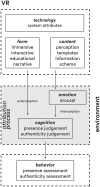Authenticity and presence: defining perceived quality in VR experiences
- PMID: 38708019
- PMCID: PMC11066206
- DOI: 10.3389/fpsyg.2024.1291650
Authenticity and presence: defining perceived quality in VR experiences
Abstract
This work expands the existing understanding of quality assessments of VR experiences. Historically, VR quality has focused on presence and immersion, but current discourse emphasizes plausibility and believability as critical for lifelike, credible VR. However, the two concepts are often conflated, leading to confusion. This paper proposes viewing them as subsets of authenticity and presents a structured hierarchy delineating their differences and connections. Additionally, coherence and congruence are presented as complementary quality functions that integrate internal and external logic. The paper considers quality formation in the experience of authenticity inside VR emphasizing that distinguishing authenticity in terms of precise quality features are essential for accurate assessments. Evaluating quality requires a holistic approach across perceptual, cognitive, and emotional factors. This model provides theoretical grounding for assessing the quality of VR experiences.
Keywords: authenticity; believability; plausibility; presence; user experience; user-perceived quality; virtual reality (VR).
Copyright © 2024 Hameed and Perkis.
Conflict of interest statement
The authors declare that the research was conducted in the absence of any commercial or financial relationships that could be construed as a potential conflict of interest.
Figures



References
-
- Alexander A. L., Brunyé T., Sidman J., Weil S. A. (2005). From Gaming to Training: A Review of Studies on Fidelity, Immersion, Presence, and Buy-in and their Effects on Transfer in PC-Based Simulations and Games, Vol. 5. Woburn, MA: DARWARS Training Impact Group, 1–14.
-
- Baños R. M., Botella C., Garcia-Palacios A., Villa H., Perpiñá C., Alcaniz M. (2000). Presence and reality judgment in virtual environments: a unitary construct? CyberPsychol. Behav. 3, 327–335. 10.1089/10949310050078760 - DOI
-
- Barricelli B. R., Gadia D., Rizzi A., Marini D. L. (2016). Semiotics of virtual reality as a communication process. Behav. Inf. Technol. 35, 879–896. 10.1080/0144929X.2016.1212092 - DOI
-
- Beckhaus S., Lindeman R. W. (2011). Experiential fidelity: leveraging the mind to improve the VR experience, in Virtual Realities: Dagstuhl Seminar 2008 (Cham: Springer; ), 39–49. 10.1007/978-3-211-99178-7_3 - DOI
LinkOut - more resources
Full Text Sources

